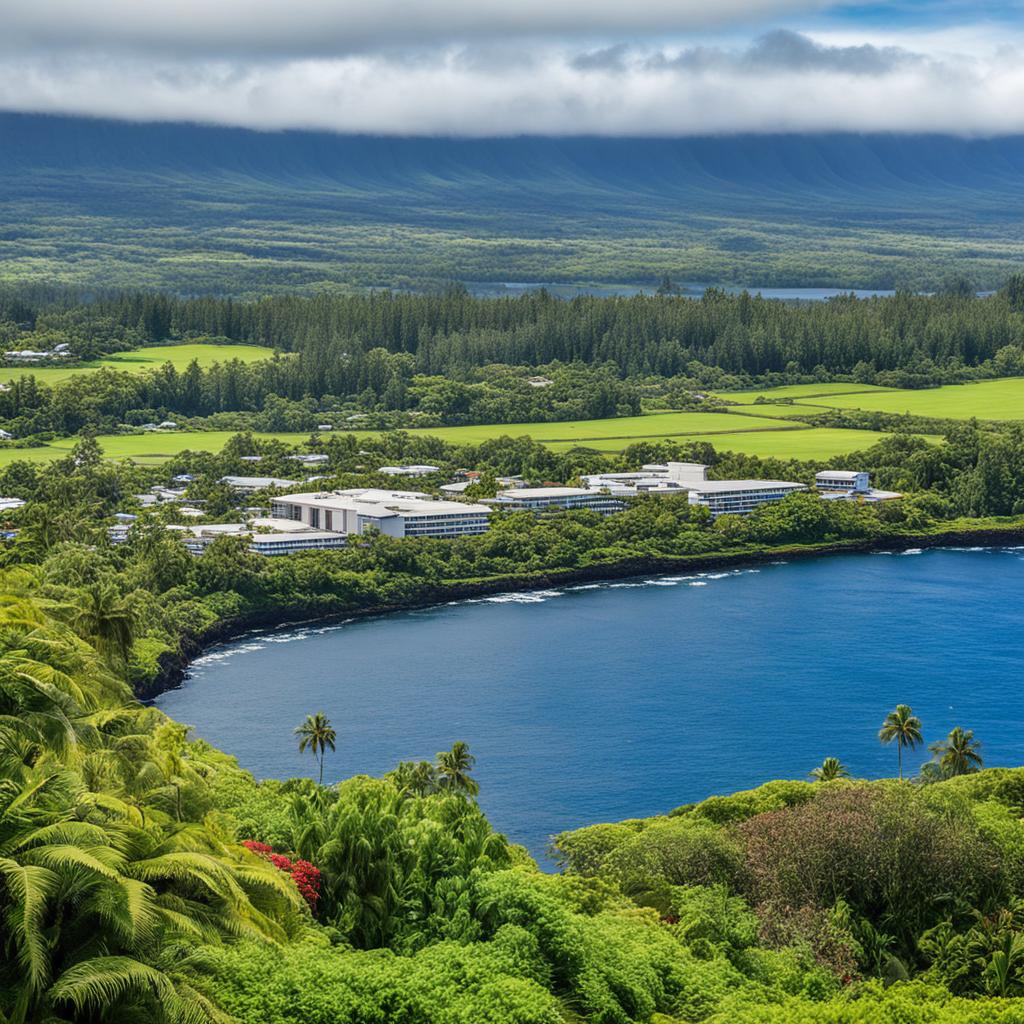Hawaii is often considered one of the most expensive places to live in the United States, with a cost of living that is 46% higher than the national average. However, there are affordable options available for those looking to relocate to this tropical paradise. In this ultimate guide, we will explore the best and cheapest places to live in Hawaii, providing insights into housing prices, living expenses, and more.
When considering the cost of living in Hawaii, it’s important to take into account several factors. Housing prices, which are significantly higher than the national average, can greatly impact the overall cost of living. Additionally, everyday expenses such as groceries and utilities can also be higher in Hawaii compared to other states.
However, it’s not all doom and gloom. Hawaii offers a unique and beautiful lifestyle that many find to be worth the extra cost. From stunning beaches to breathtaking landscapes, there is no shortage of natural beauty to enjoy. Plus, the friendly and welcoming culture of the islands adds to the overall appeal.
Throughout this guide, we will delve into the different areas of Hawaii and highlight the cheapest places to live. Whether you’re looking for a bustling city or a more laid-back town, there is a location in Hawaii that can fit your budget and lifestyle.
Key Takeaways:
- Hawaii has a cost of living that is 46% higher than the national average.
- Affordable options do exist for those looking to live in Hawaii.
- Factors such as housing prices and everyday expenses contribute to the overall cost of living in Hawaii.
- The unique beauty and culture of Hawaii make it an attractive place to live despite the higher cost.
- Throughout this guide, we will explore the cheapest places to live in Hawaii and provide insights into housing prices and living expenses.
Is it financially smart to move to Hawaii?
Moving to Hawaii can be an enticing prospect for many, with its breathtaking natural beauty, warm weather, and laid-back island lifestyle. However, before making the decision to relocate, it’s important to consider the financial implications and evaluate whether it aligns with your personal and financial goals.
Living in Hawaii comes with a high cost of living, which is 46% higher than the national average. From housing prices to everyday expenses, the cost can add up. While the salaries in Hawaii are generally higher compared to the national average, it’s crucial to assess whether your income will be sufficient to cover the increased expenses.
It’s worth noting that moving to Hawaii can be financially smart for individuals with well-paying jobs or those who can find suitable employment opportunities on the islands. With a healthy income, you can better adjust to the higher cost of living and enjoy the many advantages of living in this tropical paradise.
Additionally, it’s crucial to budget wisely and manage your finances effectively. By understanding the local expenses and making informed choices about housing, transportation, and everyday expenses, you can navigate the cost of living efficiently and enjoy the unique lifestyle the Hawaiian islands have to offer.
Here’s a helpful table summarizing the key factors to consider when evaluating the financial smartness of moving to Hawaii:
| Factors to Consider | Financial Implications |
|---|---|
| Housing prices | Higher than the national average; varies by the island and location. |
| Everyday expenses | Cost of groceries, utilities, and transportation can be higher compared to the mainland. |
| Income levels | Salaries in Hawaii are generally higher, but you need to ensure yours is sufficient to cover the cost of living. |
| Job opportunities | Evaluate the employment market and the availability of suitable jobs in your field. |
| Lifestyle adjustment | Assess your ability to adapt to the island lifestyle and embrace its unique challenges. |
Ultimately, whether moving to Hawaii is financially smart depends on your individual circumstances, financial goals, and ability to manage the higher cost of living. It’s essential to carefully consider all the financial implications and make an informed decision that aligns with your long-term financial well-being.
For those who prioritize the island lifestyle and are prepared for the financial commitment, moving to Hawaii can be a rewarding experience. However, it’s important to approach it with realistic expectations and a solid financial plan in place. By doing so, you can make the most of your time in this beautiful and vibrant part of the United States.
Cost of Living in Hawaii Compared to National Average
When it comes to the cost of living, Hawaii stands out as one of the most expensive places in the nation. According to the Missouri Economic Research and Information Center, Hawaii has the highest cost of living in the country, with an index of 191.8, compared to the national average index of 100.
This high cost of living is influenced by various factors, including housing prices, groceries, and utilities. Let’s take a closer look at each of these aspects:
Housing Prices
Hawaii’s housing market is notorious for its high prices. From single-family homes to apartments, the cost of housing in Hawaii is significantly higher than the national average. This is especially true in major cities like Honolulu, where housing prices can be astronomical.
Table: Median Home Prices in Hawaii (March 2023)
| Island | Median Home Price |
|---|---|
| Oahu | $1,100,000 |
| Maui | $950,000 |
| Big Island | $750,000 |
| Kauai | $760,000 |
Groceries
Buying groceries in Hawaii can be a costly affair. Due to its geographic location, the state heavily relies on imported goods, which drives up the prices of everyday items. From fresh produce to dairy products, expect to pay more for groceries in Hawaii compared to the national average.
Utilities
Utilities in Hawaii can also take a toll on your wallet. The cost of electricity, water, and other essential services tends to be higher than the national average. This can significantly impact your monthly expenses and overall cost of living in Hawaii.
“Hawaii has the highest cost of living in the nation, with an index of 191.8.”
As the data from the Missouri Economic Research and Information Center demonstrates, the cost of living in Hawaii is significantly higher than the national average. It’s important to consider these factors when planning a relocation or budgeting for everyday expenses. By being aware of the higher costs associated with living in Hawaii, you can make informed decisions to ensure your financial well-being.
Average Income in Hawaii
The average income in Hawaii plays a significant role in understanding the challenges residents face in affording the high cost of living in the state. In 2019, according to the U.S. Census, the median household income in Honolulu, Hawaii was approximately $80,000. This figure provides a glimpse into the earning potential for individuals and families living in the capital city.
However, it’s important to note that studies suggest a much higher income is needed to live comfortably in Hawaii’s bustling capital. With the high cost of housing, transportation, groceries, and other daily expenses, a salary of $80,000 may not stretch as far as one might hope.
Studies indicate that an income of $200,000 or more is required to maintain a comfortable standard of living in Honolulu. This income disparity highlights the financial challenges many residents face in meeting the demands of Hawaii’s costly lifestyle.
The wide discrepancy between the median income and the income needed for comfort underscores the financial pressures individuals and families experience on a daily basis. Despite the allure of the island paradise, it’s crucial to carefully consider the financial implications of living in Hawaii and to plan accordingly.
Housing Prices in Hawaii
When considering a move to Hawaii, one of the crucial factors to examine is the housing market. The average sale price of a home in Hawaii was $970,000 in March 2023, according to data from the Hawaii State. However, it’s important to note that the market has seen a decline in home sales, with a significant 37% decrease compared to the previous year.
It’s worth mentioning that each island in Hawaii has its own unique real estate market, offering different median prices. For instance, Honolulu, with its close proximity to the business district, tends to have the highest housing prices across the state.
When searching for a home in Hawaii, it’s essential to consider both your budget and the location that suits your needs. Whether you’re looking for a luxurious property or a more modest dwelling, Hawaii’s real estate market offers a diverse range of options to cater to various preferences and budgets.
Rising Costs and Market Trends
As demand for housing in Hawaii continues to outpace supply, housing prices have shown a consistent upward trend. This rise is influenced by factors such as limited land availability, high construction costs, and the desirability of the Hawaiian lifestyle.
“The rise in Hawaii’s housing prices reflects the unique appeal of living in paradise. With stunning natural landscapes, a vibrant culture, and a year-round tropical climate, it’s no surprise that people are willing to invest in Hawaii’s real estate market.”
– Real Estate Expert
Investing in a property in Hawaii can provide not only a place to call home, but also potential long-term financial benefits. The housing market has historically exhibited appreciation, contributing to the overall value of real estate in the state.
Choosing the Right Location
Hawaii’s islands offer a range of neighborhoods and communities, each with its own distinct features and amenities. Whether you prefer the bustling city life of Honolulu or the serene tranquility of a smaller town, it’s important to find a location that suits your lifestyle and budget.
Researching the different islands and their respective housing markets will help you identify regions with more affordable options that align with your preferences. Exploring areas such as Hilo, Waianae, Kahului, Kapa’a, and Ewa Beach can provide insights into communities that offer a more reasonable cost of living compared to some of the more expensive areas in Hawaii.
| Island | Median Home Price |
|---|---|
| Hawaii | $675,000 |
| Kauai | $787,500 |
| Lanai | $555,000 |
| Maui | $860,000 |
| Molokai | $380,000 |
| Oahu | $865,000 |
When deciding on a location in Hawaii, it’s crucial to consider factors such as proximity to amenities, job opportunities, and the overall lifestyle you desire. Each island offers a unique experience, and finding the right balance between budget and location is key to finding your ideal home in paradise.
Cost of Renting in Hawaii
Rent prices for apartments in Hawaii can vary depending on the island and location. In Honolulu, the average rent for a studio apartment is $1,745, while a one-bedroom apartment costs around $2,102. The highest rental prices are typically found in Honolulu due to its proximity to job opportunities and the business district. However, other islands, such as the Big Island, often have lower rent prices.
| Apartment Type | Average Rent |
|---|---|
| Studio Apartment | $1,745 |
| One-Bedroom Apartment | $2,102 |
Comparative Rent Prices in Different Hawaiian Islands
The cost of renting an apartment in Hawaii can vary significantly depending on the island. While Honolulu has higher rent prices, other islands offer more affordable options. Here is a comparative overview of average rent prices across different Hawaiian islands:
| Island | Average Rent |
|---|---|
| Oahu (Honolulu) | $2,102 |
| Hawaii (Big Island) | $1,800 |
| Maui | $2,500 |
| Kauai | $2,200 |
| Lanai | $1,600 |
| Molokai | $1,300 |
“While Honolulu may have the highest rental prices, there are more affordable housing options available on other islands like Hawaii, Maui, Kauai, Lanai, and Molokai.”
Everyday Expenses in Hawaii
Living in Hawaii comes with its unique set of expenses. Everyday essentials like utilities and groceries can be pricier compared to the national average. Here’s a breakdown of the costs you can expect:
Hawaii Utilities Cost
When it comes to electricity, be prepared for higher bills. The average cost of electricity in Hawaii is $342 per month, which is above the national average.
Cost of Groceries in Hawaii
Buying groceries in Hawaii can take a toll on your wallet. The costs are often higher due to the expenses associated with shipping goods to the islands. While the prices can vary, it’s important to budget accordingly and prioritize essential items.
It’s worth noting that gas prices in Hawaii can also be higher, depending on the island you’re on. In Honolulu, for example, the average price per gallon is around $4.90.
Managing your everyday expenses in Hawaii requires careful budgeting and adjusting to the higher costs. By being aware of these factors, you can plan your finances accordingly and make the most of your time in paradise.
Low Income Threshold in Hawaii
In Hawaii, the U.S. Department of Housing and Urban Development (HUD) defines a “low income” threshold for individuals living on Oahu. According to HUD, the low-income threshold in Hawaii is approximately $93,000, which is almost double the national average income. This significant disparity emphasizes the financial challenges faced by many residents in Hawaii, even with higher incomes compared to other parts of the country.
Critical Analysis of Low Income in Hawaii
“The U.S. Department of Housing and Urban Development considers “low income” for an individual living on Oahu to be around $93,000, almost double the national average income.”
This information raises important questions about the cost of living in Hawaii and its impact on residents, especially those with lower incomes. While it may seem counterintuitive that individuals earning close to $100,000 a year are considered low-income, it reflects the higher expenses associated with living in the state. Factors such as housing costs, utilities, and everyday expenses contribute to the financial strain experienced by many individuals and families in Hawaii.
Despite the relatively higher income levels compared to the national average, the cost of housing remains a significant challenge for low-income residents in Hawaii. The high housing prices, especially in areas like Honolulu, make it difficult for individuals and families with limited financial resources to secure affordable and suitable accommodation.
The cost of living in Hawaii extends beyond just housing. Groceries, utilities, transportation, and healthcare expenses are all higher compared to the national average. These increased costs put added pressure on individuals with limited income, requiring them to make difficult choices and compromises to meet their basic needs.
This disparity in income thresholds highlights the need for affordable housing options and support systems for low-income individuals and families in Hawaii. Local organizations, government initiatives, and community efforts play a crucial role in addressing these challenges and providing assistance to those in need.
| Low Income Threshold in Hawaii | National Average Income |
|---|---|
| $93,000 | Approximately $47,000 |
Table: Comparison of Low Income Threshold in Hawaii and National Average Income
Despite the higher income required to be considered low-income in Hawaii, it is essential to recognize the financial struggles faced by many residents. Efforts to address these disparities and provide support for low-income individuals and families are crucial for promoting a more inclusive and equitable society.
Taxation in Hawaii
When considering the cost of living in Hawaii, it is important to understand the state’s taxation policies. Hawaii imposes certain taxes on its residents and businesses, which can have an impact on their finances. Let’s take a closer look at the various taxes in Hawaii.
Hawaii Income Tax
Hawaii has a progressive income tax system, with rates ranging from 1.4% to 11%. The state’s top income tax rate of 11% is higher than the national average, which can significantly affect high earners in Hawaii. However, it’s worth noting that Hawaii also provides various tax credits, exemptions, and deductions that can help offset the tax burden for certain individuals and families.
Hawaii Property Tax
When it comes to property taxes, Hawaii has the lowest effective property tax rate in the country. The state’s property tax rate is set at just 0.27% annually, which is significantly lower than the national average. This is good news for homeowners in Hawaii, as it means they can enjoy a relatively lower tax burden on their properties compared to residents in other states.
Hawaii General Excise Tax
Businesses operating in Hawaii are subject to the General Excise Tax (GET). The GET is a transaction-based tax levied on all business activities, including sales of goods and services. The standard rate for the GET is 4%, but Honolulu County has an additional 0.5% override, making it a total of 4.5% for businesses located in the county. This tax can impact the overall cost of goods and services in Hawaii.
Here’s a summary of the key taxation in Hawaii:
| Tax | Rate | Notes |
|---|---|---|
| Hawaii Income Tax | 1.4% – 11% | Progressive tax system |
| Hawaii Property Tax | 0.27% annually | Lowest effective property tax rate in the country |
| Hawaii General Excise Tax | 4% (4.5% for businesses in Honolulu County) | Applied to all business activities |
While the income tax rate in Hawaii is higher than the national average, the state’s low property tax rate can offer some relief for homeowners. However, businesses should consider the impact of the general excise tax when operating in Hawaii.
Cheapest Places to Live in Hawaii – Hilo
Hilo, located on the eastern side of the big island of Hawaii, offers a more affordable cost of living compared to other parts of the state. With a median rent price of $1,650 and a median household income of $70,356, Hilo provides a more affordable option for those looking to live in Hawaii.

If you’re dreaming of living in paradise without breaking the bank, Hilo is a great choice. This charming town not only has breathtaking natural beauty but also offers a lower cost of living compared to other popular destinations in Hawaii.
When it comes to housing, Hilo’s median rent price of $1,650 is significantly more affordable than places like Honolulu or Waikiki. Whether you’re looking for an apartment or a house, you’ll find a range of options that fit your budget.
Additionally, Hilo boasts a median household income of $70,356, which provides residents with a decent standard of living. While it may not be as high as some other cities in Hawaii, Hilo’s lower cost of living helps balance out the equation.
Beyond the financial aspect, Hilo offers a unique lifestyle that combines the tranquility of nature with a vibrant community. You’ll have access to stunning beaches, lush rainforests, and breathtaking waterfalls, all within a short drive from your doorstep. The town also hosts cultural events and festivals that showcase the rich history and traditions of Hawaii.
Why Choose Hilo?
- Affordable housing options compared to other parts of Hawaii
- Breathtaking natural beauty, including beaches, rainforests, and waterfalls
- A vibrant community with cultural events and festivals
- Lower cost of living while still enjoying the island lifestyle
Living in Hilo allows you to experience the magic of Hawaii without breaking the bank. From its affordable housing options to its stunning natural beauty, Hilo offers the perfect blend of affordability and paradise.
Cheapest Places to Live in Hawaii – Waianae
Looking for an affordable place to live in Hawaii? Consider Waianae, located on the scenic west coast of Oahu. With its breathtaking ocean views and tight-knit community, Waianae offers a unique and more affordable experience compared to other parts of the state.
Unlike the bustling city life of Honolulu, Waianae provides a quieter and more relaxed atmosphere that appeals to those seeking a slower pace of living. The community is known for its strong sense of unity and deep-rooted cultural heritage, making it an ideal place for individuals and families looking for a close-knit neighborhood.
When it comes to the cost of living, Waianae stands out as one of the cheapest places to live in Hawaii. The median rent price in Waianae is approximately $2,100, which is considerably lower compared to other areas in Oahu. Additionally, the median household income in Waianae is around $71,681, providing a more balanced financial equation for residents.
While Waianae may have a lower cost of living, it still offers plenty of amenities and resources for its residents. The area boasts beautiful beaches, hiking trails, and parks, allowing for easy access to outdoor activities and a laid-back lifestyle. Essential services, such as grocery stores, healthcare facilities, and schools, are also conveniently situated within the community.
Waianae Cost of Living Comparison
| Category | Waianae | Oahu Average | National Average |
|---|---|---|---|
| Housing | $2,100 (median rent price) | $2,400 (median rent price) | $1,500 (median rent price) |
| Utilities | Similar to Oahu average | Higher than national average | Varies by location |
| Groceries | Similar to Oahu average | Higher than national average | Varies by location |
| Transportation | Similar to Oahu average | Similar to national average | Varies by location |
As highlighted in the table above, Waianae’s cost of living in terms of housing, utilities, groceries, and transportation is comparable to the Oahu average. However, it’s important to note that Waianae’s cost of living is typically higher than the national average overall due to the unique factors associated with living in Hawaii.
Living in Waianae provides a more affordable option for individuals and families looking to enjoy the beauty and culture of Hawaii without breaking the bank. The tight-knit community and stunning natural surroundings make Waianae a hidden gem on Oahu’s west coast.
If you’re searching for an affordable place to call home in Hawaii, consider Waianae. With its affordable real estate options, strong sense of community, and access to nature, Waianae offers an enticing opportunity to live a more affordable island lifestyle.
Cheapest Places to Live in Hawaii – Kahului
Kahului, located on the island of Maui, is one of the most affordable places to live in Hawaii. This charming town offers a range of housing options that cater to different budgets, making it an attractive choice for those seeking an affordable cost of living.
With a median rent price of $2,300 and a median household income of $82,219, Kahului strikes a balance between affordability and access to amenities and resources. Whether you’re renting or looking to buy a home, Kahului offers options that can fit your budget while providing a high quality of life.
Despite the lower cost of living, Kahului doesn’t skimp on convenience. The town is home to many shops, restaurants, and entertainment venues, ensuring you have everything you need within reach. Plus, being located on Maui, you’ll have access to stunning beaches, lush landscapes, and a vibrant island culture that makes Hawaii so special.
The Cost of Living in Kahului
To give you a clearer picture of the cost of living in Kahului, here’s a breakdown of some key expenses:
| Expense | Average Cost |
|---|---|
| Rent for a 1-Bedroom Apartment | $2,300 per month |
| Groceries | Comparable to the national average |
| Utilities | Varies depending on usage |
| Transportation | Gas prices are higher due to the island location |
Keep in mind that these costs can fluctuate based on personal expenses and lifestyle choices. However, compared to other parts of Hawaii, Kahului offers an affordable living experience.
Whether you’re a young professional, a retiree, or a family, Kahului is a great option if you’re looking for an affordable place to live in Hawaii. Its lower cost of living and access to amenities make it an attractive choice for those seeking a balance between affordability and quality of life.
Cheapest Places to Live in Hawaii – Kapa’a
I have always been fascinated by the beauty of Kauai, and Kapa’a, located on the east side of the island, is one of the most affordable places to live in Hawaii. This charming town offers a range of housing options that cater to different budgets, making it an attractive choice for those seeking an affordable lifestyle in Hawaii.
One of the advantages of living in Kapa’a is the access to various outdoor activities. The town is surrounded by stunning natural beauty, including pristine beaches, lush mountains, and picturesque hiking trails. Whether you enjoy surfing, snorkeling, or simply taking a leisurely walk along the shore, Kapa’a has something to offer everyone.
Now, let’s talk numbers. The median rent price in Kapa’a is around $4,500, which may seem high compared to the national average, but it is relatively affordable within the context of Hawaii’s housing market. Additionally, the median household income in Kapa’a is approximately $94,457, providing residents with a decent income to support their cost of living.

To give you a better perspective, I have outlined some key data in the table below:
| Key Factors | Kapa’a | National Average |
|---|---|---|
| Median Rent Price | $4,500 | $1,500 |
| Median Household Income | $94,457 | $63,179 |
| Cost of Groceries | 10% higher | N/A |
| Gas Prices | 20% higher | N/A |
The table highlights the affordability of Kapa’a in comparison to the national average. While the cost of groceries and gas prices may be slightly higher, it is important to consider the unique factors of living in Hawaii, such as the remote location and the cost of shipping goods to the islands.
Living in Kapa’a offers a balance between affordability and the opportunity to immerse yourself in the natural wonders of Kauai. It is a place where you can enjoy a laid-back lifestyle without sacrificing the beauty and uniqueness of Hawaii.
If you’re considering a move to Hawaii and are looking for an affordable place to live, Kapa’a should be on your radar. With its affordable housing options, access to outdoor activities, and vibrant community, Kapa’a offers a quality of life that is hard to find elsewhere.
Cheapest Places to Live in Hawaii – Ewa Beach
Ewa Beach, once a sugar plantation town, is now a charming suburban area located just 35 minutes north of Honolulu. Its historical roots combined with its convenient proximity to the capital city make Ewa Beach an attractive and affordable place to live in Hawaii.
Ewa Beach offers a mix of affordability and a laid-back island lifestyle. With a median rent price of $3,700, residents can find more budget-friendly housing options compared to other parts of Hawaii. The cost of living in Ewa Beach is also relatively affordable, allowing individuals and families to live comfortably without breaking the bank.
Despite its affordability, Ewa Beach doesn’t compromise on access to amenities and outdoor recreation opportunities. The area boasts beautiful beaches, parks, and golf courses, providing residents with ample opportunities for leisure and relaxation.
“Ewa Beach offers the perfect balance of affordability and convenience. We’re close enough to Honolulu for work and entertainment, but still maintain a peaceful suburban atmosphere.” – Resident of Ewa Beach
Whether you’re looking to enjoy the stunning sunsets, spend time at the beach, or explore the local culture, Ewa Beach has something to offer for everyone. With its affordable cost of living and diverse range of attractions, Ewa Beach is one of the top choices when it comes to the cheapest places to live in Hawaii.
Key Statistics for Ewa Beach
| Median Rent Price | $3,700 |
|---|---|
| Median Household Income | $108,953 |
Conclusion
Living in Hawaii doesn’t have to be out of reach for those on a budget. Despite its reputation for high living costs, there are affordable places to call home within the state. Hilo, Waianae, Kahului, Kapa’a, and Ewa Beach offer a more affordable cost of living compared to other parts of Hawaii.
When considering where to live in Hawaii, it is essential to take into account factors such as housing prices, everyday expenses, and income levels. By carefully planning and budgeting, it is possible to enjoy the beauty and lifestyle of Hawaii without breaking the bank.
Whether you’re attracted to the lush landscapes of Hilo, the close-knit community of Waianae, the amenities of Kahului, the outdoor adventures in Kapa’a, or the suburban lifestyle of Ewa Beach, these affordable options provide a chance to experience the wonders of Hawaii without sacrificing your financial well-being.
So, if you dream of living in Hawaii and exploring its stunning beaches, vibrant culture, and breathtaking scenery, don’t let the cost of living deter you. With the best cheapest places to live in Hawaii, you can enjoy the aloha spirit and make your island dreams come true.
FAQ
Is Hawaii a good place to live financially?
How does the cost of living in Hawaii compare to the national average?
What is the average income in Hawaii?
How much does a home in Hawaii cost?
What are the rental prices like in Hawaii?
FAQ
Is Hawaii a good place to live financially?
Moving to Hawaii can be a smart move for individuals with well-paying jobs who can adapt to the high cost of living and embrace the island lifestyle. However, it is important to understand the financial implications and make sure it aligns with your personal and financial goals.
How does the cost of living in Hawaii compare to the national average?
According to a study by the Missouri Economic Research and Information Center, Hawaii has the highest cost of living in the nation with an index of 191.8, compared to the national average index of 100. This high cost of living is driven by factors such as housing prices, groceries, and utilities.
What is the average income in Hawaii?
The median household income in Honolulu, Hawaii was around ,000 in 2019, according to the U.S. Census. However, studies suggest that an income of 0,000 or more is required to live comfortably in Hawaii’s capital city.
How much does a home in Hawaii cost?
The average sale price of a home in Hawaii was 0,000 in March 2023, according to data from the Hawaii State. Each island in Hawaii has its own unique real estate market and median prices, with Honolulu having the highest prices due to its proximity to the business district.
What are the rental prices like in Hawaii?
Rent prices for apartments in Hawaii can vary depending on the island and location. In Honolulu, the average rent for a studio apartment is
FAQ
Is Hawaii a good place to live financially?
Moving to Hawaii can be a smart move for individuals with well-paying jobs who can adapt to the high cost of living and embrace the island lifestyle. However, it is important to understand the financial implications and make sure it aligns with your personal and financial goals.
How does the cost of living in Hawaii compare to the national average?
According to a study by the Missouri Economic Research and Information Center, Hawaii has the highest cost of living in the nation with an index of 191.8, compared to the national average index of 100. This high cost of living is driven by factors such as housing prices, groceries, and utilities.
What is the average income in Hawaii?
The median household income in Honolulu, Hawaii was around $80,000 in 2019, according to the U.S. Census. However, studies suggest that an income of $200,000 or more is required to live comfortably in Hawaii’s capital city.
How much does a home in Hawaii cost?
The average sale price of a home in Hawaii was $970,000 in March 2023, according to data from the Hawaii State. Each island in Hawaii has its own unique real estate market and median prices, with Honolulu having the highest prices due to its proximity to the business district.
What are the rental prices like in Hawaii?
Rent prices for apartments in Hawaii can vary depending on the island and location. In Honolulu, the average rent for a studio apartment is $1,745, while a one-bedroom apartment costs around $2,102. The highest rental prices are typically found in Honolulu due to its proximity to job opportunities and the business district.
How expensive are everyday expenses in Hawaii?
Everyday expenses in Hawaii can be higher than the national average. The average cost of electricity is $342 per month, and gas prices in Hawaii vary depending on the island, with the average price in Honolulu being around $4.90 per gallon. Groceries in Hawaii are also more expensive due to the costs of shipping them to the islands.
What is considered low income in Hawaii?
The U.S. Department of Housing and Urban Development (HUD) considers “low income” for an individual living on Oahu to be around $93,000, which is almost double the national average income. This disparity highlights the financial challenges many residents face in Hawaii, even with higher incomes compared to other parts of the country.
What are the taxation rates in Hawaii?
Hawaii has a top income tax rate of 11% and the lowest effective property tax rate of just 0.27% annually. Additionally, businesses in Hawaii are subject to a 4% general excise tax on all activities, with an additional 0.5% override for Honolulu County.
What are some of the cheapest places to live in Hawaii?
Some of the cheapest places to live in Hawaii include Hilo, Waianae, Kahului, Kapa’a, and Ewa Beach. These areas provide a more affordable cost of living compared to other parts of Hawaii.
,745, while a one-bedroom apartment costs around ,102. The highest rental prices are typically found in Honolulu due to its proximity to job opportunities and the business district.
How expensive are everyday expenses in Hawaii?
Everyday expenses in Hawaii can be higher than the national average. The average cost of electricity is 2 per month, and gas prices in Hawaii vary depending on the island, with the average price in Honolulu being around .90 per gallon. Groceries in Hawaii are also more expensive due to the costs of shipping them to the islands.
What is considered low income in Hawaii?
The U.S. Department of Housing and Urban Development (HUD) considers “low income” for an individual living on Oahu to be around ,000, which is almost double the national average income. This disparity highlights the financial challenges many residents face in Hawaii, even with higher incomes compared to other parts of the country.
What are the taxation rates in Hawaii?
Hawaii has a top income tax rate of 11% and the lowest effective property tax rate of just 0.27% annually. Additionally, businesses in Hawaii are subject to a 4% general excise tax on all activities, with an additional 0.5% override for Honolulu County.
What are some of the cheapest places to live in Hawaii?
Some of the cheapest places to live in Hawaii include Hilo, Waianae, Kahului, Kapa’a, and Ewa Beach. These areas provide a more affordable cost of living compared to other parts of Hawaii.
How expensive are everyday expenses in Hawaii?
What is considered low income in Hawaii?
What are the taxation rates in Hawaii?
What are some of the cheapest places to live in Hawaii?
Source Links
- https://www.royalhawaiianmovers.com/cheapest-places-to-live-in-hawaii/
- https://www.sofi.com/best-affordable-places-to-live-in-hawaii/
- https://www.dwellhawaii.com/blog/cost-of-living-in-hawaii/
Money posts:
 Retiring in Hawaii: Complete Guide (2024)
Retiring in Hawaii: Complete Guide (2024)
 Retiring in Rhode Island: Complete Guide (2024)
Retiring in Rhode Island: Complete Guide (2024)
 Cost of Living Arkansas: Best Cheapest Places | Ultimate Guide 2024
Cost of Living Arkansas: Best Cheapest Places | Ultimate Guide 2024
 Cost of Living Idaho: Best Cheapest Places | Ultimate Guide 2024
Cost of Living Idaho: Best Cheapest Places | Ultimate Guide 2024
 Cost of Living Alaska: Best Cheapest Places | Ultimate Guide 2024
Cost of Living Alaska: Best Cheapest Places | Ultimate Guide 2024
 Cost of Living Delaware: Best Cheapest Places | Ultimate Guide 2024
Cost of Living Delaware: Best Cheapest Places | Ultimate Guide 2024
 Cost of Living Colorado: Best Cheapest Places | Ultimate Guide 2024
Cost of Living Colorado: Best Cheapest Places | Ultimate Guide 2024
 Cost of Living California: Best Cheapest Places | Ultimate Guide 2024
Cost of Living California: Best Cheapest Places | Ultimate Guide 2024

